The Amphitheatre of Pula in Croatia
Also known as the Pula Arena, is a well-preserved Roman amphitheater located in Pula, Croatia. Here is a brief history of the Amphitheatre:
Ancient Origins: The construction of the Amphitheatre of Pula began during the reign of Emperor Augustus in the 1st century AD. It was built on the site of an earlier Hellenistic period theater. The exact date of its completion is uncertain but is believed to be around the 1st century AD. In Roman Era, The amphitheater was primarily used for gladiatorial contests and other public spectacles popular in ancient Rome. It could accommodate up to 23,000 spectators and was an important venue for entertainment and social gatherings.
Pula was founded by the ancient Greeks, and its heyday fell on the days of Ancient Rome. At different times it belonged to Venice, Austria, Italy, Yugoslavia, and now this city is one of the largest in Croatia.
A rich history has left its mark on the streets of this amazing city. Here you can visit the Roman Theater and the Hercules Gate. The local Colosseum hosts concerts and performances. In the western part of the city you can see the Franciscan monastery, and on a high hill is the Venetian fortress.
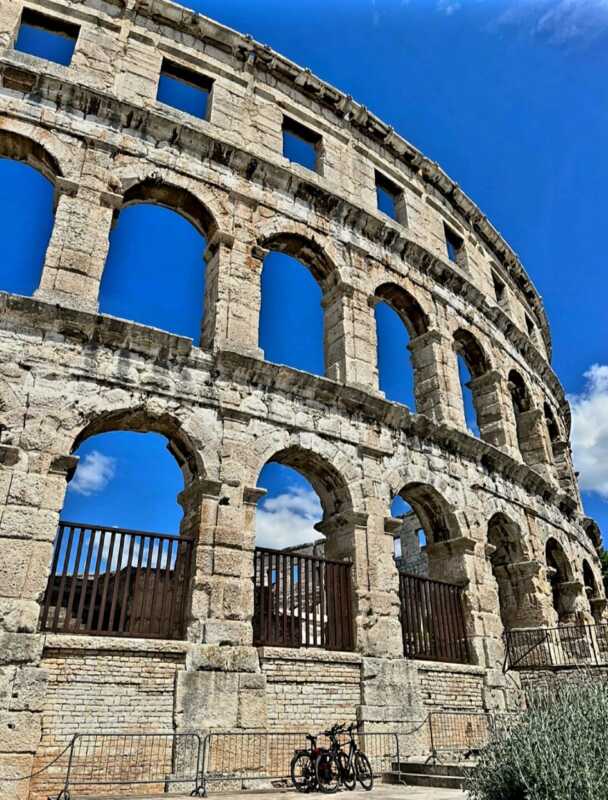
Architecture and Design – Amphitheatre of Pula
The Amphitheatre of Pula is one of the best-preserved Roman amphitheaters in the world. It was built using local limestone and measures approximately 132 meters in length and 105 meters in width. The exterior of the amphitheater features three levels of arches, with a total of 72 arches in the façade. The inner part of the amphitheater consists of a central arena surrounded by a series of concentric walls and seating tiers.
Built by the sea, the outer walls are made of regular limestone blocks. The façade facing the sea has three floors and a maximum height of around 30 m, while the rest of its perimeter only has two heights because it takes advantage of the unevenness of the terrain. The first two levels have 72 semicircular arches each, while the last one has 64 flat arches.
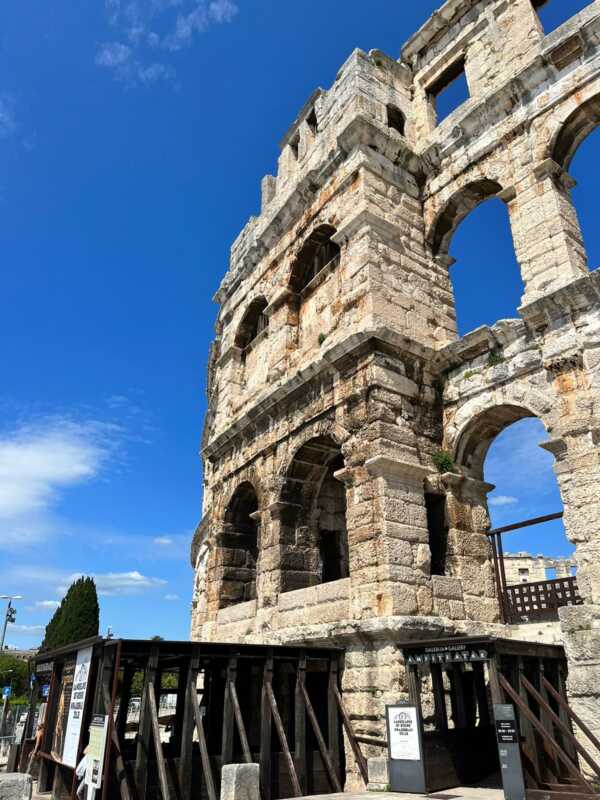
The major axis of the elliptical plan of the amphitheater is 132.45 m and the minor 105.1 m. The cavea (tiers) could originally accommodate some 23,000 spectators on its 40 steps, partly supported on the slope that descends towards the coast. The arena of the enclosure has dimensions of 67.95 m by 41.65 m and is separated from the cavea by a small wall in which fifteen doors open. Under the arena there are a series of corridors and subterranean rooms that were originally used to shelter wild beasts and gladiators who took part in the shows. Under the stands there are also various dependencies and warehouses.
Each of the four towers has two cisterns that were filled with scented water, which was used both to supply a fountain and to sprinkle spectators. The stands of the amphitheater could be covered with velarii, large canopies that protected attendees from the sun or rain.
Samsung Store: Galaxy Z Fold4

Medieval Period on Amphitheatre of Pula
After the decline of the Roman Empire, the amphitheater was used for various purposes. In the 5th century, during the early Byzantine period, the amphitheater was fortified and used as a defensive structure against invading barbarian tribes.
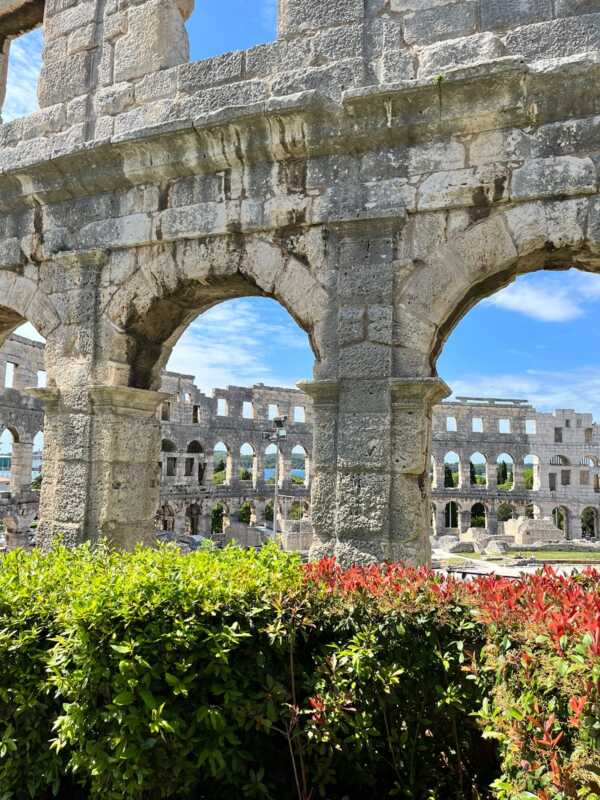
In the Middle Ages, Pula came under the control of the Venetian Republic. The amphitheater was used as a source of building materials, and its stone was used for the construction of various buildings in Pula. During the Middle Ages, the interior of the arena was used as an enclosure for grazing cattle, for occasional tournaments by the Knights of the Order of Malta, and to host fairs.
Under the rule of the Republic of Venice
In 1583 the Senate of the Republic of Venice proposed to dismantle the amphitheater and rebuild it stone by stone in Venice itself, although the idea was rejected. Today there is a stone plaque in the second tower that commemorates this proposal and celebrates the opposition of the Venetian senator Gabriele Emo to its execution. In 1709 some stones were extracted from the amphitheater and used in the foundations of the bell tower of Pula Cathedral, although it was the last time the Roman building was used as a quarry.
French Step
At the beginning of the 19th century, the French general Auguste Marmont, governor of the Illyrian Provinces, began the restoration of the amphitheatre. The works continued from 1816 under the direction of the Italian Pietro Nobile at the request of Emperor Francis I of Austria. In 1932 the Pula amphitheater was adapted to host theatrical productions, military parades and all kinds of public events. Currently, its stands have room for 5,000 spectators and it is a regular place for holding concerts.
Today, the Amphitheatre of Pula is one of the most popular tourist attractions in Croatia. It serves as a venue for various cultural events, including concerts, theatrical performances, and the Pula Film Festival, which takes place annually.
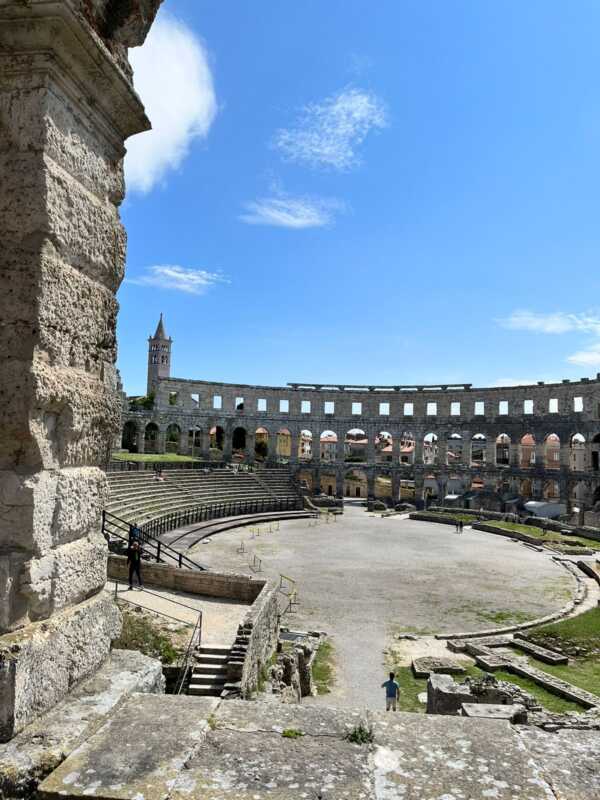
The Amphitheatre of Pula stands as a testament to the architectural and engineering prowess of the ancient Romans and provides valuable insights into the social and cultural aspects of the Roman era in this region.The mythical origin of Pula is located in time, in a precious legend according to which it was founded by some warriors who, chasing Jason to recover the Golden Fleece without success, did not dare to return to Colchis and chose to settle in the place.
The Days of Antiquity – Pula Superiorum
Is a huge cultural event that is very significant for the region of Istria. This impressive festival has been organised for almost 20 years now and it presents the famous Roman history in the most authentic way.
It takes place on the most famous historical spots in Pula and it is held on Fridays and Saturdays only, during the months of May and June. The incredible program is repeated each weekend so visitors have enough time to attain it. It combines education and entertainment through music, dance, theatre, gastronomy and history, making sure each spectator dives in to the astonishing roman way of living. Original post
When you walk the enchanting streets of Pula, you will notice the remains of rich roman heritage almost on every step. The trademark Pula is most known for, is for sure one magnificent monument – the Amphitheatre. The main event of the festival is happening there. Other spots where the program is happening are the Roman Square Forum, the area in front of the Temple of Augustus and the Town Hall.
On all these locations
visitors will learn more about the Roman Empire through intriguing performances and scenery. Society in ancient Rome was hierarchical and the festival’s organisers do their best to present it through different workshops, art exhibitions, open theatre performances and trade presentations. The clothing of each actor is very detailed; make up, jewellery, hair styles, togas, and footwear will make you feel like you walked into some Hollywood movie set. The people representing craftsmen, use replicas of the tools which ancient Romans used when they were making items. Everything is carefully conceptualised, as the goal is to present everyday life in Roman society, in the most authentic way. No wonder this event has an extraordinary tourist significance, also for the promotion of Istria.

To get a better picture of what you can experience, let us give you a tour of the festival. In 2019 a big roman wedding was organised for the first time, where all viewers could see the rituals and ceremonies that happen before the wedding ceremony. The preparation of the bride and groom, dances, songs, entertainment and all the preparatory ceremonies. Since the Romans were famous for celebrations and hedonism, the wedding ceremony ended with an extensive roman feast.
Every year the organisers
make sure all age groups can benefit from the festival, so there are workshops, food and souvenirs you can try and buy at any point of time. Usually there is a Roman breakfast, where you can taste some delicacies prepared the roman way. At the workshops you can learn for example how to make jewellery, soaps, scents or mosaic. Little visitors can take part in a school for little gladiators, different ancient-crafts workshops and watch children’s plays. They are held during the day on different locations. across old town. The adult plays are performed in the evenings at the Roman Square Forum, in front of the Temple of Augustus or the Town Hall. You can see ancient dances, roman instrument performers, also enjoy famous dramatic and humorous sketches.
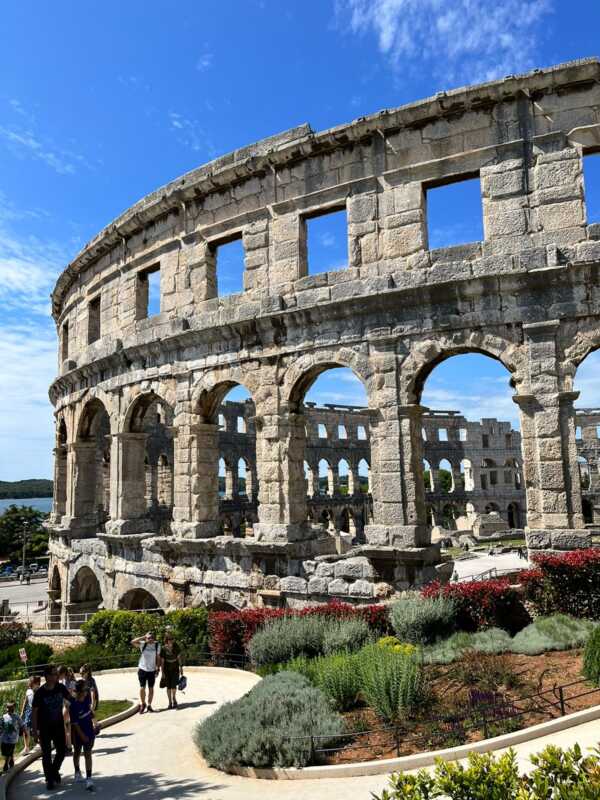
Don’t be surprised to see some craftsmen while walking the ancient streets of Pula, such as stonemasons and blacksmiths. You can see them using ancient tools, while making items like stone vessels or the famous gladiator sword called the “gladius”. At any point you can walk up to them and ask questions, take pictures, or maybe try to make something on your own.
If you stay in Pula during the Days of Antiquity, you will also see fully equipped legionaries marching the streets with their leader Centurion. They might look very intimidating at first with their helmets, armours, shields, swords and famous red tunics – but they are super friendly and are happy to take pictures with spectators at any time.
The main spectacular event – the gladiator fights, are held in the Amphitheatre as part of the historical and entertainment program “Spectacvla Antiqva”. The gladiator actors prepare and train for this manifestation for a full year, so you have the chance to watch them at the gladiator ceremony, with skills and performance in the same way they did it back in the day. That is one spectacular sight and for a moment you will have to remind yourself you are actually in the present year.

If any fans of the “Gladiator” movie are reading this, “The Pula Superiorum” shouldn’t be missed. The festival is a great opportunity to go trough an invisible time capsule and walk the Roman streets in the town of Pula. It is a family friendly manifestation and will make your visit worthwhile for sure. The whole town fills with music and scents from the past and the old-town’s monuments come to life. If you ever wanted to experience a piece of history, this is the place to be. Do not hesitate, treat yourself with a vacation in one of our amazing villas with pool in Pula and we will help you find the best accommodation, so you can cross it off your “to do “ list. Packing for a new adventure can start!
Pula Superiorum 2019
Forum Square, 6 pm – 10 pm Forum Square, The 17th Festival of Antiquity – Pula Svperiorvm is a response to the need for creating a recognizable music and theater program and educational event, bringing visitors closer to this great period of the three-thousand-year-old history of Pula and its surroundings. This year’s Days of Antiquity – Pula Svperiorvm bring an incredible program full of exciting events.
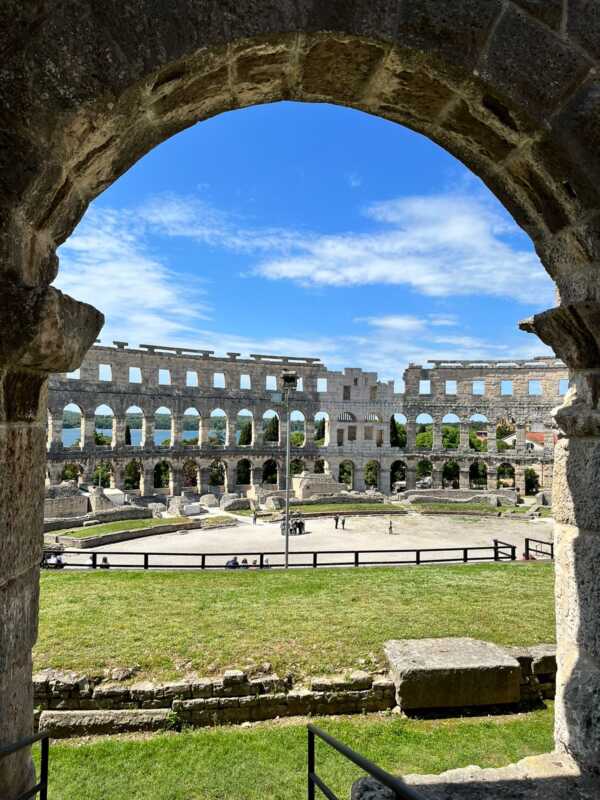
The festival venue is the central Roman square – Forum, the area in front of the excellently preserved Temple of Augustus and the Town Hall, which form a perfect background for the rich festival program. This year the music and theater program will be held on May 24, May 31, June 7, June 14 and June 15 from 6 pm to 10 pm and June 1, June 8 and June 15 from 10 am to 1 pm Especially attractive parts of the festival are gladiator fights, held in the Arena as part of the historical and entertainment program Spectacvla Antiqva. This ancient spectacle, which has already attracted thousands of visitors, will be held on June 15, 2019 at 7.30 pm.
Days of Antiquity – Pula Superiorum 2019 Friday 24.05., 31.05., 7.06., 14.06. A ROMAN WEDDING Forum 18:00 – 22:00 Ancient crafts 18:00 A small school of gladiators 19:00 – introduction of the bride and groom 19:30 The corner of Ancient Domine – clothing the bride 20:00 Introducing the legionnaires and gladiators to the groom 20:30 The Roman wedding – ceremony 20:50 A roman dance in honor of the newlyweds 21:00 A Roman feast 21:30 Ancient Roman play Saturday 1.06., 8.06. Forum 10:00 Ancient crafts and children’s workshops 10:30 A roman children’s play 11:00 A small school of gladiators Saturday 15.06. 10:00 Forum: Ancient crafts and children’s workshops 10:30 Forum: A roman children’s play 11:00 Forum: A small school of gladiators 17:30 – 18.30 Forum: The corner of ancient Domine 18:00 – 22:00 Forum: Ancient crafts 18:30 Portarata – Forum – Arena: Gladiator parade 19:30 Arena: Spectacula Antiqua – gladiator fights 20.45 Forum: A Roman feast 21:00 Gallery Cvajner: Opening of the exhibition – Antiquity in a modern way – VI. Edition 21:30 Forum: Ancient Dance 21:45 Forum: Ancient Music






